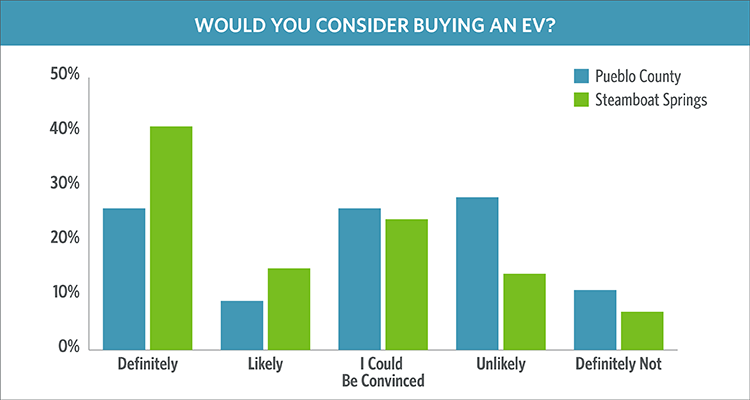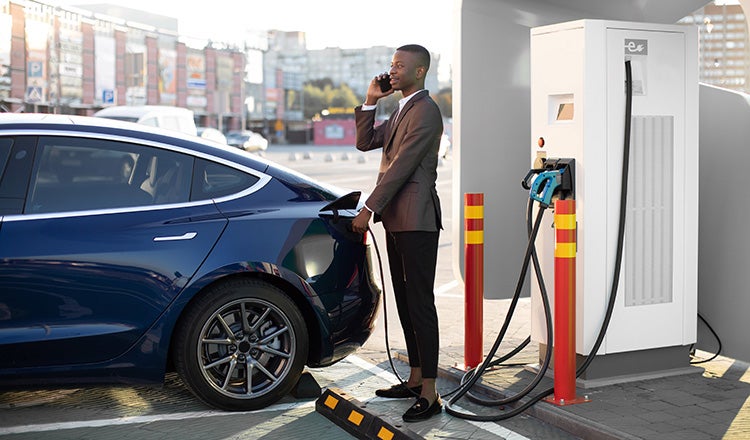
Experts Talk: Developing Statewide Electric Vehicle Marketing Plans with Katie Angell
Experts Talk is an interview series with technical leaders from across our transportation program.
Creating a Cohesive Plan to Educate Residents on the Benefits of Switching to Electric
Transportation is the largest contributor to greenhouse gas emissions, accounting for 29% of the total U.S. emissions in 2022. Increasing the adoption of electric vehicles is a key strategy for reducing those emissions, and many U.S. states are creating policies and plans to promote this technology. Consumer knowledge, however, has often lagged behind, leaving an information gap that needs to be filled to ensure that states’ electric vehicle adoption efforts succeed.

Our Strategic Communications Project Manager Katie Angell is an expert at managing education and awareness campaigns, overseeing public engagement through traditional and progressive outreach strategies, and building strong stakeholder relationships. She has led strategic communications efforts on multiple community electric vehicle readiness plans as well as stakeholder engagement on Colorado’s recent statewide transportation safety plan. In this interview, she explains why widespread EV education plans are needed, how and when to start one, and important elements for communities to consider.
Q. Why do states need an education and marketing plan for promoting electric vehicle adoption?
A. Cities and states across the U.S. are working toward a more sustainable transportation future by adding the infrastructure needed to support new mobility technology, including electric vehicles. But the technical and infrastructure component is only part of the solution. Education is also needed to help eliminate the mystery surrounding these new EV technologies, reduce residents’ fears and encourage them to make use of the new infrastructure being installed.
Many communities have already begun this process by creating community preparedness plans. The educational benefits realized in these localized efforts can be amplified through a larger regional or statewide plan that incorporates the gains already made and adds strategies to speak to previously unreached communities.
We know through our research and experience that fear or lack of knowledge about new technology is a major barrier to EV adoption. Amid worries about range, cost, selection and more, the challenge is: How can we effectively guide our communities to switch from gas-powered vehicles to EVs?
The answer is implementing a widespread education campaign to help our communities better understand EVs, their capabilities, the true cost of ownership, charging infrastructure, the incentives available and more reasons that make operating an EV preferred over gas-powered vehicles.

Q. When should states begin thinking about public and stakeholder engagement on electric vehicles?
A. As early as possible. Even before developing a widespread education and awareness campaign, stakeholder and public engagement should be included within EV infrastructure readiness planning efforts. Involving our communities early in the planning process helps public transportation agencies and planners understand existing public perceptions and buyer behaviours. Early engagement also builds initial EV public education while identifying partnerships and industry stakeholders who can support future marketing efforts.
These partnerships can help with future implementation of EV readiness strategies. For example, having early conversations with local dealerships, fleet management companies and property management companies provides a better understanding of their future goals related to EV. Early discussions also help show these partners the benefits of supporting a wider statewide plan and how they can support these broader public education and behaviour shifts.
And this information proves vital in developing larger plans. Discussions with community partners and affected groups can help inform planning for future infrastructure, revealing community needs and barriers that may otherwise go unnoticed.
Q. What does this public EV engagement look like?
A. This engagement can be implemented using a variety of tools including market research, stakeholder interviews and public events.
For example, as part of HDR’s work developing EV readiness plans for Pueblo County and Steamboat Springs, we conducted public surveys. We asked the same questions for each and the responses were very different. One question was “would you consider buying an EV?” as noted in the chart below. Pueblo County’s responses weighed more heavily on the unlikely to definitely not responses, whereas Steamboat Springs’ responses leaned more toward definitely.

Not only did these surveys provide a better understanding of the communities’ perception and experience around EVs, it began public education by introducing the communities to the topic early during the planning efforts. As a campaign continues, these pulse surveys of residents can be repeated to provide an ongoing window into the efficacy of the public outreach, showing whether awareness is growing, knowledge is expanding and consumer interest is increasing.
Q. What obstacles can a statewide electric vehicle education plan help overcome?
A. Adopting and adapting to new technologies is exciting yet challenging. One nationwide survey in 2020 found that 98% of drivers had heard of EVs, but only 30% felt knowledgeable about them. In other words, more than two-thirds of drivers are lacking basic knowledge about EVs. It makes sense then that about the same portion — 69% of respondents — said they did not plan on their next vehicle being electric. Building awareness to make people feel more comfortable about these vehicles is our main challenge — or rather opportunity — and a well-executed education plan can help us overcome this.
This process of EV enlightenment requires understanding the EV market, perceived local barriers and the consumer purchase process. Each community and each state is different, and the reasons given by drivers for not knowing about or wanting an EV differ. In some areas, it’s a perceived lack of public charging infrastructure. In others it’s the cost of the vehicles. Still other residents may not like available models or be worried about charging time. All of these concerns can be addressed through a well-structured campaign that educates consumers about the opportunities they may not realize exist, whether public charging stations have been installed in their communities, incentive programs for purchasing a vehicle and more.
An education and awareness campaign can be especially useful for underserved, low income and/or rural communities. EV accessibility and improved air quality are ultimately a community-wide concern and should be addressed with community-wide solutions. It’s important to include each of these communities in all planning, partnerships, policies, education and outreach. Mapping communities and analyzing the air quality impacts can serve as the basis for equity considerations, policy development, adoption strategies, and other planning and education efforts.
Because of the large range of obstacles, it’s important that those creating an education and awareness campaign understand on a deep level what they are trying to teach others. Successful teams include not just communication consultants and strategists, but also representatives of the communities being addressed and technical experts who closely follow and work daily with current EV infrastructure. A strong grasp of what’s happening now and what’s coming are key to creating a campaign that speaks authoritatively on these issues.

Q. States and regions have many different communities and residents. How can electric vehicle marketing efforts be customized to reach all of these diverse audiences?
A. The single most important method of igniting widespread public awareness and behaviour change is a clear and captivating idea and message, accompanied by eye-catching branding, distributed in a powerful and lasting way.
A successful education and awareness campaign, whether it be statewide, regional or for a single town, begins with learning everything possible about its audience. This information can be collected and analyzed using a variety of data collection tools, such as market research, general census data, socioeconomic trends and social listening. Together, this information provides a better understanding of the audience’s EV adoption beliefs, fears, barriers and plans for future EV purchases. This can also tell us how people get their information so that custom strategies match their communication preferences.
The goal of this audience research is twofold. First, to identify the biggest and most impactful information gaps and prioritize a campaign to address those gaps. Second, to customize outreach strategies to be the most effective in reaching each demographic.
For example, ESRI’s Tapestry Segmentation can be used to classify neighbourhoods by socioeconomic information and demographics, providing detailed information on how people in those areas prefer to communicate, how they spend their time, their education level and more. That data then informs outreach efforts designed to resonate with each group. Multilingual and multigenerational Hispanic households can be reached through advertisements in Spanish or interviews on Spanish-language television and radio. Parents interested in shopping and leisure as well as family-friendly activities can be reached through sponsored activities at the zoo or parks. In all cases, the materials and events share a consistent brand visual and tone, which provides a cohesive campaign identity and reinforces the messaging through repeated exposure.
Inspiration & Advice
Q. How did you become involved in supporting EV communications efforts?
A. I became involved in EV communications efforts when Colorado communities began developing EV readiness campaigns, including the city of Steamboat Springs and Pueblo County. These planning efforts included a robust community and stakeholder involvement process that I helped lead. With this experience, I am now inspired by these efforts and helping on several EV and zero emissions mobility planning and marketing efforts around the country, with the support of our 130-plus strategic communications professionals at HDR.
Q. What advice would you offer someone starting in the field?
A. The first step to working in the EV and zero emissions mobility industry is to do your research. Understand existing EVs and other new mobility trends in the market, how the community perceives them and the existing buyer behaviors. Understand the current infrastructure and the barriers related to owning an EV. This knowledge will help build communications and marketing strategies that offer an inclusive, effective and meaningful approach.
Each Experts Talk interview illuminates a different aspect of transportation infrastructure planning, design and delivery. Check back regularly to see new insights from the specialized experts and thought leaders behind our award-winning, full service consulting practice.



